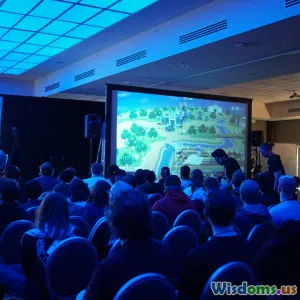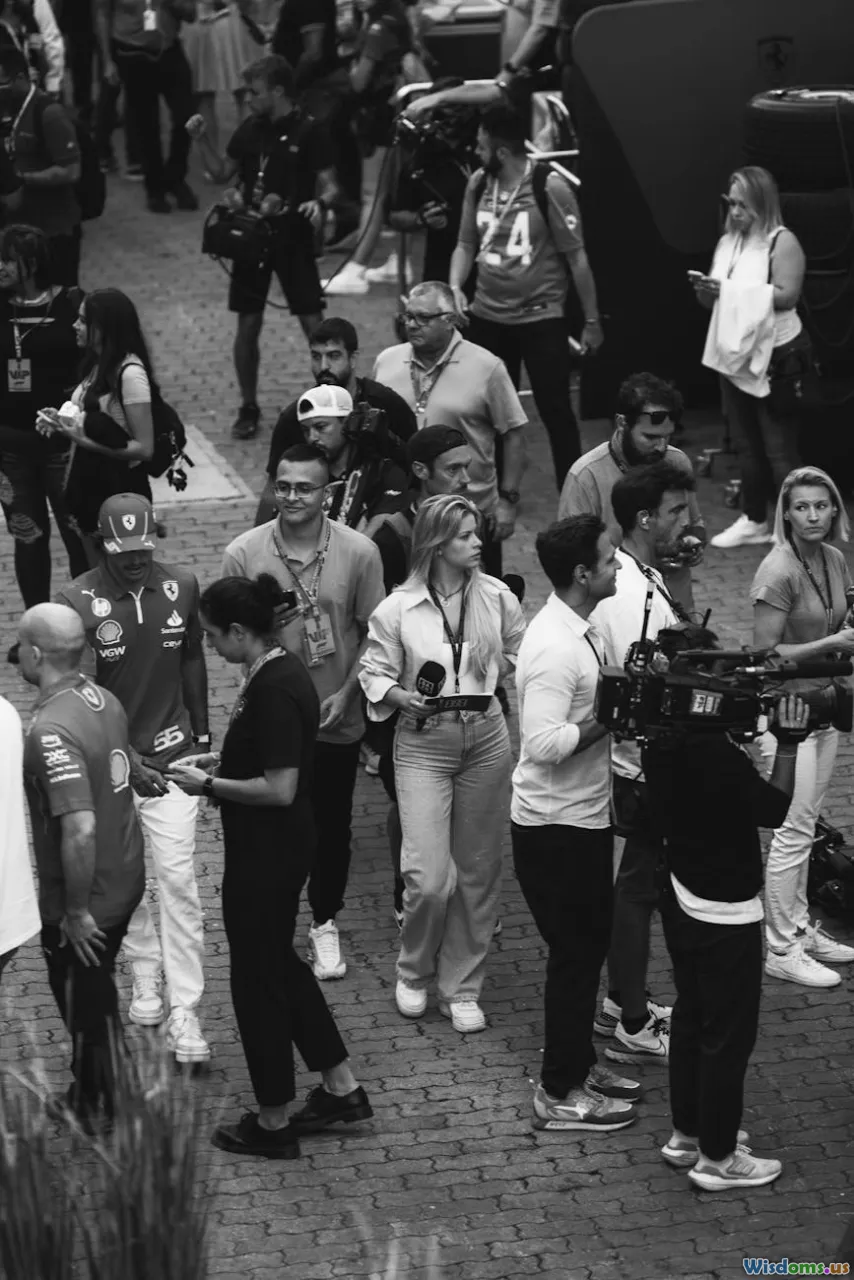
Behind the Scenes at E3 Developer Presentations
16 min read Explore exclusive insights into E3 developer presentations, revealing the creative process, technical challenges, and behind-the-scenes teamwork driving iconic gaming showcases. (0 Reviews)
Behind the Scenes at E3 Developer Presentations
While fans eagerly await the flashes of new game announcements and jaw-dropping gameplay reveals streamed live from E3 each summer, another story unfolds out of frame—in the bustling corridors, hushed rehearsal rooms, and strategy war rooms where game developers orchestrate their presentations. Getting a slice of the spotlight at the Electronic Entertainment Expo is a high-stakes endeavor demanding technical precision, storytelling brilliance, audience insight, and off-the-charts nerves. Let’s step behind the curtain and explore what it really takes to put on those unforgettable E3 developer presentations.
Months in the Making: Planning the E3 Presentation

For most studios, preparing for E3 starts long before the first booth is constructed or demo console powered on. Developers and publishers often lock in their E3 strategies six to nine months ahead—a cycle that begins with reviewing company objectives, major milestones for game development, and marketing goals.
For example, Ubisoft is known to synchronize their E3 plans with internal 'greenlight reviews,' ensuring the projects showcased are polished enough to withstand global scrutiny. This phase involves:
- Identifying Showcase Titles: Which games are ready for prime time? Titles chosen are typically six to eighteen months away from shipping for maximum impact.
- Demo Development: Creating vertical slices or specially tailored demos distinct from the actual game build. These are lightweight, hyper-optimized, and often feature bespoke assets and scripts to ensure nothing goes wrong under the spotlight.
- Storyboarding and Narrative: Narrative designers and producers collaborate to devise the on-stage story, deciding what features, trailers, and technical accomplishments will resonate with both gamers and media.
Studios must anticipate questions the audience will have. As Nathan Vella of Capybara Games once shared after their “Below” reveal, "You have to think ten moves ahead. What do you show? What do you not show? Every detail gets dissected."
Choreographing the Big Moment: Rehearsals and Run-Throughs

No matter how much preparation goes into developing game builds and trailers, the human factor is what makes or breaks an E3 demo. This is why many studios treat their E3 presentations like a Broadway opening night.
The Script
Developers work closely with PR and communications teams to craft scripts that balance authenticity, technical stats, and excitement. A natural delivery is critical—audiences quickly tune out when presenters seem like they're reading.
Rehearsals
Expect exhaustive run-throughs on mock stages, sometimes weeks before the show. Major studios such as Microsoft, Sony, and Nintendo book rehearsal spaces where their developers can fine-tune their timing (sometimes down to the second), practice handoffs for live demos, and anticipate potential slip-ups. For example, Sony required developers for “God of War” (2016) to rehearse live gameplay multiple times per day a full month prior to E3 2016.
Handling the Unexpected
Veteran presenter Joseph Staten, who spearheaded many "Halo" and "Destiny" reveals, has shared that "the first thirty seconds are the most terrifying." Developers employ mental rehearsal, scenario mapping, and even backup plans—such as "dummy" gameplay captures in case their live demo falters.
In 2017, Nintendo did a dry run for "Super Mario Odyssey" with two separate Switch units ready backstage, ensuring Mario wouldn’t be caught sleeping on screen due to a technical hiccup.
Polishing the Demo: Sleepless Nights and Technical Wizardry

Perhaps the most closely guarded E3 secret is what truly goes into building an E3 demo. The “vertical slice” is a hybrid build created at breakneck pace. It must look stunning but is often teetering on the edge of technical feasibility.
The E3 Demo isn’t the Whole Game
Stories abound of studios pulling all-nighters upgrading shaders, fixing lighting pipelines, and ensuring characters don’t T-pose during a live session. Naughty Dog’s “Uncharted 4” famously froze during its 2015 demo, but backup save states allowed Nate and Sully to rebound quickly. Developers post-mortem these nerves, calling it the ultimate pressure test for gaming code.
Controls and Authenticity
For honesty’s sake—and because gaming fans detect fakes—some studios insist on live gameplay. In 2019, CD Projekt Red showcased “Cyberpunk 2077” live for a select behind-closed-doors audience to prove the AI and pathfinding truly worked. These sessions, however, often require:
- Hard-coded encounters
- Preset enemy behaviors
- Scripted pathways that minimize technical strain
As the Lead Technical Director of Insomniac Games confessed, "Our engineer literally monitored the memory usage live as we played, sweating bullets the whole time."
The Do’s and Don'ts of Dazzling at E3

What lessons do veteran devs have for making an E3 presentation land with both critics and fans? Pattern analysis across dozens of shows reveals common themes among the standout moments.
The Do’s
- Engage Emotionally: The breathtaking reveal of “The Legend of Zelda: Breath of the Wild” wasn’t just about graphics—it was about watching fans react in awe as a beloved franchise evolved.
- Surprise & Delight: Unexpected moments, such as Keanu Reeves’ legendary “You’re breathtaking!” appearance for “Cyberpunk 2077,” live forever in viral gaming lore.
- Tell a Story: Effective demos make each feature reveal a chapter in an unfolding narrative. Following the 2016 “God of War” demo’s emotional opening, the gameplay seamlessly revealed new mechanics.
The Don’ts
- Don’t Overpromise: After the 2012 "Watch Dogs" reveal, Ubisoft learned hard lessons about showing footage that deeply differed from retail release. Gamers will dissect every detail.
- Don’t Fumble the Controls: Back in 2010, the malfunction in the “Tony Hawk: Ride” demo significantly hurt confidence in motion hardware—a cautionary tale on live hardware tests.
Media Training and Public Persona: Crafting the On-Stage Charisma

Not all the action happens on the main stage. Some of E3's biggest deals get inked in the serenity of private demo rooms, miles away from the spotlights.
The Exclusive Room
Big-name publishers like Square Enix and Capcom routinely demo in conference suites rented just for meetings with influential journalists and retail partners. These more technical demos often:
- Allow deeper Q&A with dev team leads
- Offer uncut, lengthy hands-on gameplay
- Serve as negotiating ground for promotional deals
These sessions can make or break a game’s press coverage. Favorable write-ups from these private previews (such as the first glowing hands-on for "Resident Evil 2 Remake" in 2018) can stoke anticipation months before launch.
Trust, Secrecy, and Leaks: The Battle for Hype Control

Managing the build-up to E3 requires intense secrecy—especially to prevent leaks. From encrypted drives to NDAs, the measures border on spy-movie logistics.
- Access is Sharply Limited: Demo materials are kept on isolated networks and laptops that aren’t internet-connected. In some cases, key art is only shared after the press conference.
- Partner Vetting: Trusted internal staff and external agencies are put through rigorous background checks. One ex-EA producer joked, "It was easier for me to get into our own E3 booth than into the actual trailer room."
Despite these efforts, high-profile leaks remain common. Some, like Walmart Canada's infamous 2018 leak listing 12 major unreleased games, can shake up presentations and strategies overnight.
From E3 to the World: Turning Demos into Marketing Engine

The impact of an E3 presentation echoes far beyond Los Angeles’s Convention Center. Studios deploy social media teams, influencer campaigners, and tech specialists ready to capitalize on reaction moments.
#E3Pulse: The Viral Effect
A showstopping demo can dominate Twitter (#E3), Reddit, and YouTube trends for days.
- The 2015 "Final Fantasy VII Remake" reveal ignited a storm of memes and emotional reaction videos—resulting in 100 million hashtags within 24 hours.
Post-Show Micro-Content
Game studios now prepare bite-sized previews, high-res GIFs, and Q&A kernels for influencers. In 2022, Capcom’s pre-chopped “Resident Evil: Village” clips shipped out within ten minutes of the showcase for TikTok and Instagram consumption—keeping hype engines roaring until launch.
Within hours, demo verdicts from trusted gaming journalists (IGN, GameSpot, Giant Bomb) flood the web, amplifying either applause or concerns. Teams must be ready to roll with both praise and constructive criticism, often updating build FAQs or releasing clarifying statements post-E3.
E3’s Changing Future: Digital Pivots and Developer Insight

The COVID-19 pandemic forced E3—and, by extension, the industry’s approach to big reveals—into fully virtual formats with pre-recorded videos and digital Q&A panels. This environment has altered the anatomy of developer presentations.
Pros and Cons of Going Virtual
- Pros: Fewer technical mishaps, smoother pacing, global accessibility, creative virtual set design.
- Cons: Loss of live applause, risk of looking "over-produced," harder to convey authenticity or react live.
Studios now mix high-gloss trailers with deep-dive livestreams—like Nintendo's "Treehouse Live"—offering real-time gameplay analysis and direct fan engagement.
The Developer’s Voice in a Post-Stage World
Smaller developers now enjoy equal footing with bigger publishers by leveraging Twitch, YouTube, and Discord. “Hollow Knight: Silksong” became the darling of E3 streams with a minimalist approach—a single dev playing while answering fan-submitted questions live.
Lessons from the Front Lines: Real Advice for Future Presenters

Veterans of E3 urge newcomers to always remember:
- Be flexible—anything can change in the final hour.
- Find your authentic voice—it resonates more than flashy visuals!
- Plan contingencies for every conceivable tech failure.
- Treat journalists and influencers as partners, not adversaries.
The people behind your favorite game reveals endure marathon weeks fueled by caffeine, adrenaline, and unfiltered passion. For every perfectly-timed standing ovation, there are dozens of near missfalls and back-up plans implemented with seconds to spare.
The next time you watch an E3 showstopper, remember: every demo is a patchwork of artistry, technical daring, and teamwork born over countless sleepless nights behind the scenes. Those standing ovations on stage? They’re hard-won.
Rate the Post
User Reviews
Popular Posts















